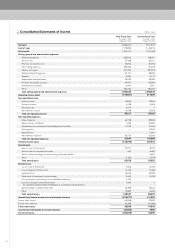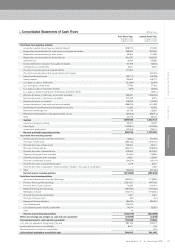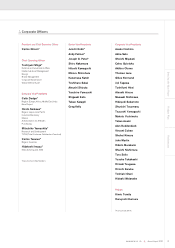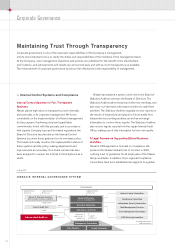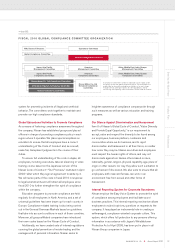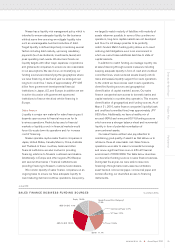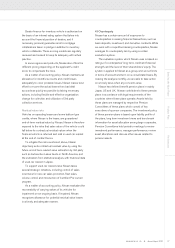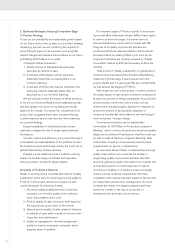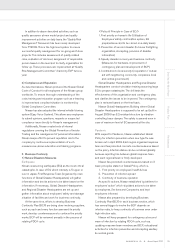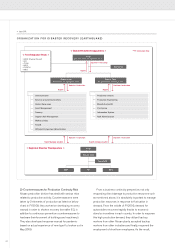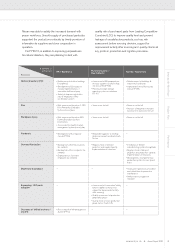Nissan 2010 Annual Report Download - page 40
Download and view the complete annual report
Please find page 40 of the 2010 Nissan annual report below. You can navigate through the pages in the report by either clicking on the pages listed below, or by using the keyword search tool below to find specific information within the annual report.
38
2. Business Strategies, Keeping Competitive Edge
1) Product Strategy
To secure our profitability and sustainable growth based
on our future product line up plan, in our product strategy
developing process, we are monitoring the impacts of
some different types of risk scenarios such as global
market changes and demand deteriorations to our future
profitability (COP) based on our plan.
<Example of Risk Scenarios>
1. Drastic decline of total global demand, past
examples as reference case.
2. A demand shift between vehicle segments
drastically faster than our assumptions in our
mid-term planning.
3. A demand shift from the matured markets to the
emerging markets drastically faster than our
assumptions in our mid-term planning.
We periodically monitor the impact of these scenarios
to secure our future profitability and sustainable growth,
and also update our future line-up plans periodically
based on the results. To improve the robustness of our
product line up against these risks, we take following
countermeasures as our main direction when planning
our product strategy.
Expand availability of individual products across
markets to mitigate the risk of single market demand
fluctuations.
Increase volume and efficiency per product through a
consolidation and rationalization of the portfolio to lower
the breakeven point and thereby reduce the profit risk of
global Total Industry Volume declines.
Prepare a more balanced product portfolio meeting
needs in a broader range of markets and segments
reducing reliance on specific large markets.
2) Quality of Products & Services
Nissan is working on the corporate task named “Quality
Leadership” which aims for achieving top level quality by
FY2012. In this project, actions are carried out with
numerical targets for following 4 areas.
1. Perceived quality & attractiveness: Customers’
impression on vehicle’s quality when customer
looks it at a dealer’s show room
2. Product quality: Quality of product itself based on
the experiences as an owner of the vehicle
3. Sales & service quality: Quality related to behavior
or attitude of sales staff or quality of service when
inspection and maintenance
4. Quality of management: internal management
quality to improve employees’ motivation which
supports above 3 qualities
For example, target of “Product quality” is to become
top level at Most Influential Indicator (MII) of each region.
In order to achieve the target, it is broken down to
internal indicators by model which correlate with MII.
Progress of all quality improvement activities are
monitored with those internal indicators. All the actions
are taken based on rotating PDCA cycle, such as, the
progress of activities are monthly reviewed by “Quality
Committee” chaired by EVP and necessary actions are
decided.
Total picture of “Quality Leadership” on global base is
monitored and discussed at the Global Quality Meeting
chaired by COO annually. 2 years passed since this
project started and it is going well. We are confident that
we can achieve the target by FY2012.
With respect to new model project, in order to achieve
the quality target of each project, milestone meetings set
at each key process of design, preparation for production
and production, confirm key check points, such as
achievement of quality targets, adoption of measures to
prevent recurrence of past problem, adoption of
measures for potential risks related to new technology /
new mechanism / design change.
Commercial production can be started after
confirmation at “SOP (Start of Production) Judgment
Meeting”, which confirms all issues are solved and quality
target can be achieved. Final decision that the model can
be sold is made at “Delivery Judgment Meeting”, after
confirmation of quality of commercial production and
preparedness for service / maintenance.
As described above, Nissan is implementing thorough
quality check before new model launch. Nissan is
progressing quality improvement activities also after
launch by gathering quality information from markets and
prompt deployment of countermeasures. In case of
occurrence of safety or compliance issues, necessary
actions such as recall are implemented with close
cooperation with market side team based on the decision
by independent process from management. Occurred
incidents are deeply investigated, analyzed and feed
backed to models on the way of production or
development for prevention of recurrence.
< >


